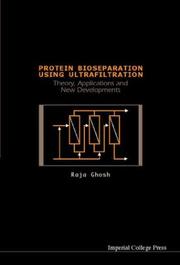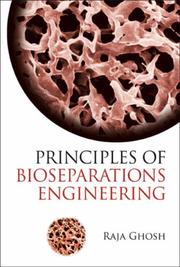| Listing 1 - 3 of 3 |
Sort by
|

ISBN: 1281866784 9786611866785 186094938X 9781860949388 9781281866783 1860943179 9781860943171 Year: 2003 Publisher: London : Imperial College Press,
Abstract | Keywords | Export | Availability | Bookmark
 Loading...
Loading...Choose an application
- Reference Manager
- EndNote
- RefWorks (Direct export to RefWorks)
Ultrafiltration is a pressure-driven, membrane-based separation process, which is used for a broad variety of applications, ranging from the processing of biological macromolecules to wastewater treatment. It has significant advantages over competing separation technologies. Food and biotechnological applications account for nearly 40% of the current total usage of ultrafiltration membranes. Protein bioseparation is an important component of this application segment. Ultrafiltration is used for protein concentration, desalting, clarification and fractionation (i.e. protein-protein separation).
Proteins --- Ultrafiltration. --- Filters and filtration --- Permeability --- Fractionation of proteins --- Protein fractionation --- Protein separation --- Resolution of proteins --- Biotechnology. --- Separation. --- Fractionation --- Resolution --- General biochemistry --- Water supply. Water treatment. Water pollution --- Biotechnology --- biochemie --- waterverontreiniging --- biotechnologie --- afvalwater

ISBN: 9812568921 9789812568922 Year: 2006 Publisher: Singapore ; Hackensack, N.J. : World Scientific,
Abstract | Keywords | Export | Availability | Bookmark
 Loading...
Loading...Choose an application
- Reference Manager
- EndNote
- RefWorks (Direct export to RefWorks)
Book
ISBN: 3642240690 3642240704 3642434371 Year: 2013 Publisher: Berlin : Springer,
Abstract | Keywords | Export | Availability | Bookmark
 Loading...
Loading...Choose an application
- Reference Manager
- EndNote
- RefWorks (Direct export to RefWorks)
This monograph forms an interdisciplinary study in atomic, molecular, and quantum information (QI) science. Here a reader will find that applications of the tools developed in QI provide new physical insights into electron optics as well as properties of atoms & molecules which, in turn, are useful in studying QI both at fundamental and applied levels. In particular, this book investigates entanglement properties of flying electronic qubits generated in some of the well known processes capable of taking place in an atom or a molecule following the absorption of a photon. Here, one can generate Coulombic or fine-structure entanglement of electronic qubits. The properties of these entanglements differ not only from each other, but also from those when spin of an inner-shell photoelectron is entangled with the polarization of the subsequent fluorescence. Spins of an outer-shell electron and of a residual photoion can have free or bound entanglement in a laboratory.
Quantum electrodynamics. --- Quantum optix. --- Quantum theory --- Electron optics --- Physics --- Physical Sciences & Mathematics --- Atomic Physics --- Electricity & Magnetism --- Philosophy --- Electronic optics --- Optics, Electronic --- Physics. --- Quantum physics. --- Atoms. --- Atomic, Molecular, Optical and Plasma Physics. --- Mathematical Methods in Physics. --- Quantum Physics. --- Quantum theory. --- Quantum optics. --- Optics --- Photons --- Quantum dynamics --- Quantum mechanics --- Quantum physics --- Mechanics --- Thermodynamics --- Chemistry, Physical and theoretical --- Matter --- Stereochemistry --- Natural philosophy --- Philosophy, Natural --- Physical sciences --- Dynamics --- Constitution --- Mathematical physics. --- Physical mathematics --- Mathematics
| Listing 1 - 3 of 3 |
Sort by
|

 Search
Search Feedback
Feedback About UniCat
About UniCat  Help
Help News
News